How To
Battle of the Browsers: Brave vs Google Chrome – Who Wins?
Learn which browser is better in our in-depth comparison.

- May 10, 2023
- Updated: March 12, 2024 at 6:58 AM

Choosing the right web browser can be complicated. Two of the top contenders for internet browsers are between Brave vs Chrome.
Many people use Google Chrome for their search queries and internet use by default, habit, convenience, or they have no idea about other options, which can also include Firefox and Safari.
In this article, we’ll explore Chrome vs Brave to help you decide which feature is most relevant to you so you can make an informed decision.
Brave vs Chrome: Quick Summary
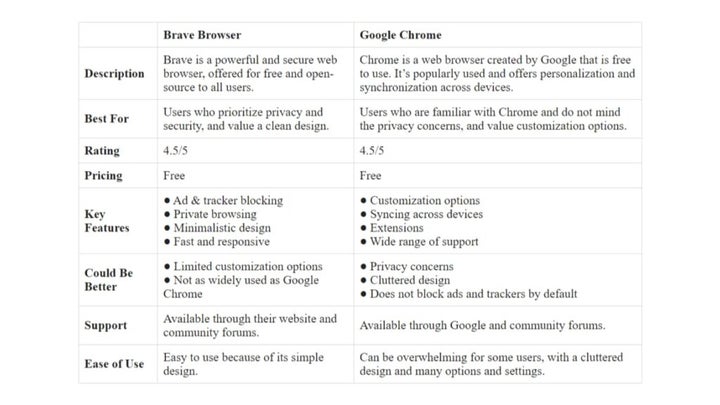
Brave and Google Chrome are both free, so below is a more detailed breakdown of these two browsers, so you have more options and avoid making a wrong choice.
Speed and Performance
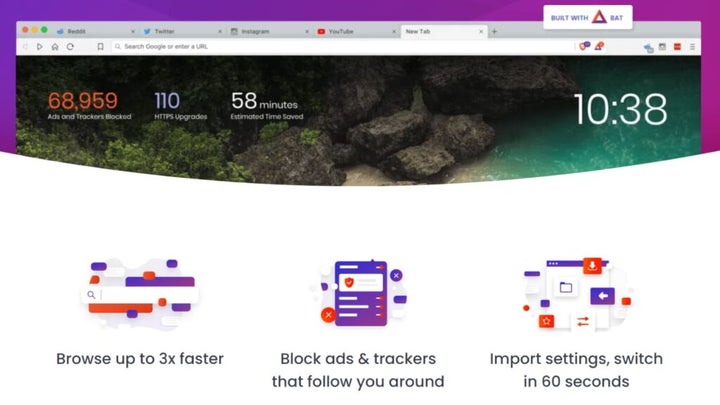
Brave Browser
Brave browser is designed with speed in mind. According to tests conducted by Brave, it loads pages 3x to 6x faster than other browsers.
Its software architecture helps minimize the amount of data and processing power required to load web pages, resulting in faster load times.
It utilizes a specialized version of Chromium, with modifications to further optimize performance and efficiency. The browser makes use of advanced compression techniques and data caching strategies, which helps in reducing data usage and improving page load speeds, even on slow or unreliable network connections.
Another reason is Brave also provides protection against trackers. Many websites use trackers to collect data on their users, which can slow down the page load time and can compromise user privacy.
These features, combined with Brave’s efficient use of resources, result in a significantly faster and more efficient browsing experience compared to Chrome.
Google Chrome
Google Chrome is also known for its fast speed and performance. The reasons include:
- Improved load times due to investment in optimizing browser experience and use of V8 JavaScript engine, which can process JavaScript code up to twice as fast as other browsers.
- Prioritizes loading of important content (text, images, videos) first, ensuring quick and seamless browsing experience.
- Use of hardware acceleration, which utilizes the user’s hardware (graphics card and CPU) to process web content, leading to smoother and faster browsing experience.
According to tests conducted by Cloudwards, Google Chrome is the fastest because of these reasons:
- Efficient use of resources, meaning it uses less memory and CPU power than other browsers.
- Streamlined design that prioritizes loading the most important content first, resulting in faster page load times.
- Its V8 JavaScript engine can process code twice as fast as other browsers.
These are extensions that can help speed up the browser even more:
- The Great Suspender. It helps increase Chrome’s speed by automatically suspending tabs that have been inactive for a specified amount of time. This helps reduce the amount of memory and CPU usage that Chrome is consuming, resulting in a faster and more responsive browser experience.
- Data Saver. It helps save data by compressing images and videos before they are loaded on a page. This reduces the amount of data that needs to be downloaded, which in turn leads to faster page load times and improved browsing performance.
- OneTab. It helps increase speed by organizing all of your tabs into one single list. When you activate the extension, it converts all of your open tabs into a list, freeing up memory and reducing the strain on your CPU. This results in a faster and more responsive browsing experience.
- AdBlock Plus. It blocks unwanted ads, banners, pop-ups, and trackers from appearing on the website you visit. This helps to improve the speed of the website as fewer resources are required to load, reducing the time it takes for pages to load and reducing data usage.
The verdict for speed and performance is clear: Google Chrome is the winner. It has a streamlined design, efficient use of resources, and powerful extensions that can help speed up your browsing experience.
Security and Privacy

Brave and Chrome have their own set of features that addresses security and privacy.
Brave Browser
Brave is one of the most secure browsers available today because of these factors:
- Prioritizes user security and privacy. Brave was created with the aim of addressing the growing concerns of internet users regarding online security and privacy. It offers a secure and private browsing experience without sacrificing speed and performance.
- HTTPS everywhere. It uses HTTPS to automatically encrypt all website connections, providing enhanced protection against malicious websites and potential cyberattacks.
- Tor mod. Brave offers a Tor mode, a feature that’s in beta, which allows users to browse the web anonymously and privately. This adds an extra layer of security as data is routed through multiple servers, making it much harder for anyone to track online activity.
- Third-party cookie blocking. It allows users to block cookies, which are often used by advertisers and other companies to track online behavior. This helps to protect personal information and browsing habits from being collected and used for malicious purposes.
- Blocks website scripts and cookies. This enhances the security of user data by preventing unauthorized access to sensitive information, such as browsing history, passwords, and personal details.
- Crypto wallet support. Brave supports cryptocurrency wallets, allowing users to store, manage, and make transactions with their digital assets securely within the browser. This eliminates the need to use third-party services that may pose a security risk.
- Open-source. As an open-source project, Brave’s code is transparent and publicly available for inspection and improvement. This can help increase security, as the community can identify or highlight any security vulnerabilities.
- Basic Attention Token (BAT) rewards for viewing ads. The BAT reward system helps to incentivize users to view ads, which helps support content creators. This system also adds an additional layer of security, as it allows users to transact and receive payments in a secure and decentralized manner, without relying on intermediaries.
Google Chrome
Google Chrome is fast, reliable, and secure, making it an ideal choice for many users.
One of the main concerns with Chrome is that it collects user data, such as browsing history, location, and search queries, and shares this information with Google for targeted advertising and other purposes.
To address security and privacy concerns, Chrome offers these features:
- Protection against phishing scams and malicious websites. It provides features such as secure browsing through HTTPS, which encrypts the data transmitted between your device and the website you’re accessing.
- Regular security updates. It’s regularly updated to address new security threats and vulnerabilities that emerge. This helps to keep users protected against evolving online risks, such as malware and viruses.
Additional Security and Privacy Factors to Consider When Using Chrome
- Limitations of private browsing mode. While Chrome’s private browsing, also known as incognito mode, prevents the browser from saving your browsing history and data, it does not protect against other forms of online tracking, such as by internet service providers or website administrators.
- Corporate interests. Google, the corporation behind Chrome, has its own interests and goals, which may not align with the privacy concerns of its users. Chrome’s privacy policy may allow for the collection of significant amounts of personal data through the browser, which some users may find uncomfortable.
For those who prioritize security and privacy, Brave is the clear winner. Brave is designed with these concerns in mind and offers a more robust protection against online risks.
Performance on Different Devices
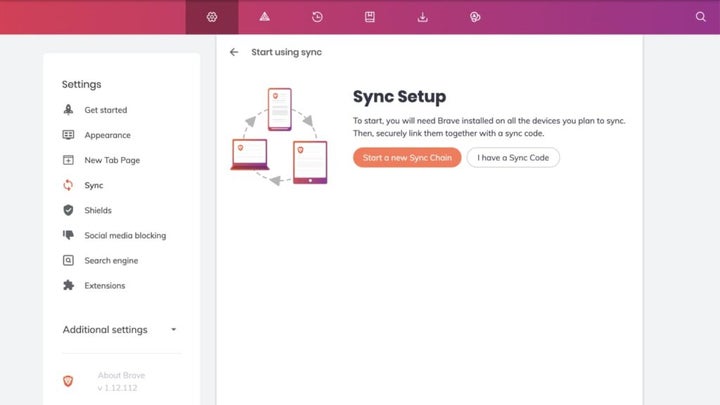
Both Brave and Google Chrome can be utilized on a number of platforms, such as Windows PC desktops, Mac laptops, Android devices, and iOS smartphones and watches.
A question that’s often asked is, “Does Brave use less RAM than Chrome?” To answer this question, we need to look at the performance of each browser on different devices.
Brave Browser
Brave’s performance varies depending on the device it is used on. Here’s a breakdown of its performance on different devices:
- Desktops: It performs well on desktops, with fast load times and smooth browsing experiences. This is because desktops typically have more powerful hardware compared to mobile devices.
- Laptops: It performs similarly to desktops, with fast load times and smooth browsing experiences. Laptops also have more powerful hardware compared to mobile devices, which contributes to its good performance.
- Tablets: It also performs well on tablets, with fast load times and smooth browsing experiences. However, performance may vary depending on the specifications of the tablet being used.
- Mobile phones: It performs well on mobile phones, but may experience some slowdown or lag compared to its performance on desktops and laptops. This is because mobile phones typically have less powerful hardware compared to these devices.
It’s worth noting that Brave’s performance may also depend on the version of the device’s operating system, available RAM, and the number of tabs and extensions being used.
Unique Features
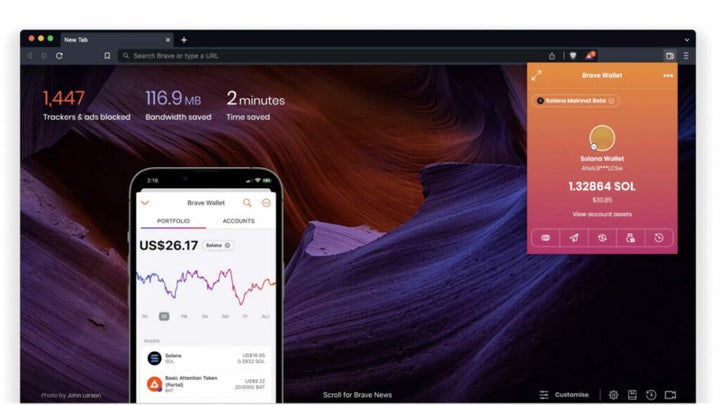
Brave also has a built-in cryptocurrency wallet, which allows you to earn and spend Basic Attention Tokens (BAT), a cryptocurrency that rewards you for your attention to ads.
This built-in cryptocurrency wallet in Brave is related to performance on different devices in several ways.
- Having a cryptocurrency wallet integrated within the browser offers an additional layer of convenience and accessibility for users, as they can manage their digital assets directly within the browser without having to switch to another platform. This can improve the overall user experience, especially for those who actively participate in the cryptocurrency economy.
- The use of blockchain technology to manage transactions within the wallet can impact the processing power required by the browser, and therefore affect its performance on devices with lower specifications. However, Brave has been designed to optimize the use of resources and minimize the impact on performance, making it suitable for use on a wide range of devices.
- It allows for a more efficient use of processing power. By allowing users to earn and spend Basic Attention Tokens (BAT), Brave incentivizes users to pay attention to advertisements, which in turn reduces the amount of unwanted or irrelevant ads that are displayed. This reduction of unwanted content can help to improve the performance of the browser on different devices, as less processing power is required to display and render the content.
In summary, Brave performs well across different devices, offering fast and smooth browsing experiences.
Google Chrome
Chrome can also be accessed on different devices.
- Desktops: It offers a smooth and fast browsing experience. Its features and extensions work seamlessly. With a fast and powerful processor and adequate RAM, Chrome can handle multiple tabs and processes with ease, making it ideal for desktops.
- Laptops: It performs similarly on laptops as it does on desktops. It provides fast and efficient browsing, and its interface is well optimized for laptop use.
- Tablets: It provides a similar browsing experience as on desktops and laptops. The interface is optimized for touch screens, providing a user-friendly and convenient experience. However, on older or lower-specification tablets, users may experience slower performance and longer load times.
- Mobile phones: It provides a fast and smooth browsing experience on mobile phones.The interface is optimized for smaller screens, with features like automatic text-wrapping and pinch-to-zoom functionality. Chrome’s extensive feature set is also available on mobile, including Incognito mode, synchronizing tabs and bookmarks across devices, and a large library of extensions.
Google Chrome provides a fast and efficient browsing experience on all devices. However, performance may vary based on the device’s specifications and hardware.
In summary, the performance of Brave and Chrome on different devices can vary depending on various factors, such as device specifications and network conditions.
On desktops and laptops, both Brave and Chrome offer smooth and fast browsing experiences with no major differences in performance.
On mobile phones, both browsers perform well, but Chrome may be more suited for devices with higher specifications due to its resource-intensive nature. Brave, on the other hand, is designed to be more efficient and can perform well on lower-end devices.
On tablets, both browsers perform well on high-end tablets, but Chrome may have a slight edge in terms of performance due to its resource-intensive nature. On lower-end tablets, Brave may perform better due to its more efficient design.
Both Brave and Chrome offer solid performance on different devices, with no major differences in performance. The choice between the two browsers may depend on other factors, such as security, privacy, and the user’s personal preferences.
Battery life
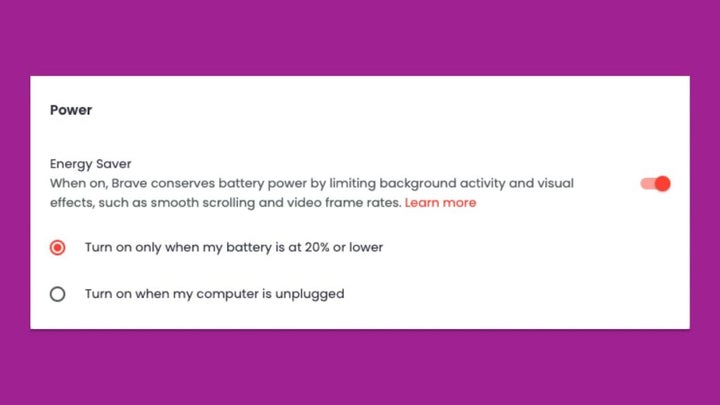
Here is a summary of the difference between the battery life of the two browsers.
Brave Browser
According to Brave, mobile users can expect up to two and a half extra hours of browsing per battery charge.
The factors that help improve Brave’s battery life include:
- Efficient use of resources. It’s designed to minimize resource usage, which translates to better battery life performance. This is because the browser is optimized to use fewer system resources, such as CPU, RAM, and battery.
- Battery saver mode. It offers a battery saver mode that reduces the battery consumption of the browser by limiting resource usage, such as by disabling background tabs. This feature is a convenient way for users to extend their battery life when needed.
- Hardware acceleration. It uses hardware acceleration to perform certain tasks more efficiently, which helps to conserve battery life. This feature takes advantage of the underlying hardware in a device, such as the GPU, to perform tasks that would otherwise require more CPU power and battery.
Google Chrome
Studies have shown that using Google Chrome can consume more battery compared to other browsers. For example, a test conducted by PCWorld compared the battery life of several popular browsers, including Google Chrome, Microsoft Edge, and Mozilla Firefox.
Features Chrome uses to improve battery life include:
- Efficient resource management. It’s designed to be efficient with device resources, using minimal processing power and memory to help extend battery life.
- Background tabs management. It has the ability to limit the activity of background tabs, reducing their impact on battery life. This means that, even if you have multiple tabs open, they won’t consume significant battery power.
- Power management API. This enables Chrome to adjust its resource usage depending on the device’s power source, reducing power consumption when running on battery power.
- Hardware acceleration. It uses hardware acceleration to offload some processing tasks from the CPU to the GPU, reducing the burden on the CPU and extending battery life.
In summary, Brave has key features that suggest it offers a longer battery life on most devices, which includes fast page loading speeds, ad and tracker blocking, and customizable settings.
Design of Browsers: How it Impacts Performance and User Experience

When comparing the design and user interface between Chrome vs Brave, both have a clean and intuitive design.
Brave Browser
These design features have a significant impact on both performance and user experience:
- Prioritizing simplicity and efficiency. This has several benefits. Firstly, it’s easier for users to navigate and find what they’re looking for, which can lead to a more efficient browsing experience. Secondly, a simpler design reduces the risk of clutter and confusion, which can lead to improved performance, as the browser has less to process and can allocate more resources to the tasks that matter.
- Minimalist interface. This helps users focus on the content they’re looking at, rather than the browser itself. This can help reduce distractions and improve the overall user experience. A minimalist interface can also help to reduce the amount of memory and processing power the browser requires, leading to improved performance and battery life.
- UI customization options. Users have the ability to personalize their browsing experience, making it easier to navigate and interact with the browser, thus providing a better user experience.
Google Chrome
Chrome also has design features that affect performance and user experience:
- User-friendly interface. It features a neat interface that makes navigation and accessing features easy. This enhances the user experience as users can quickly find what they need and carry out tasks efficiently.
- Tab management. This is designed to allow users to easily open and switch between multiple tabs. This allows for a more organized and efficient browsing experience, as users can quickly access the tabs they need without having to search for them.
- Customization. Chrome offers a variety of customization options, including themes and extensions, that allow users to personalize their browsing experience. This can impact performance and user experience as users can tailor the browser to suit their specific needs and preferences.
- Automatic updates. It’s designed to automatically update to the latest version, ensuring that users have access to the latest features and security updates. This can improve performance and user experience by fixing bugs and adding new features, as well as ensuring that the browser is secure. Users also have the option to turn off this feature.
In summary, since Brave has a more simple design and user-friendly interface, it’s ideal for users who don’t need a lot of customization options, which makes it the better choice.
Why Should I Use Brave Over Chrome?
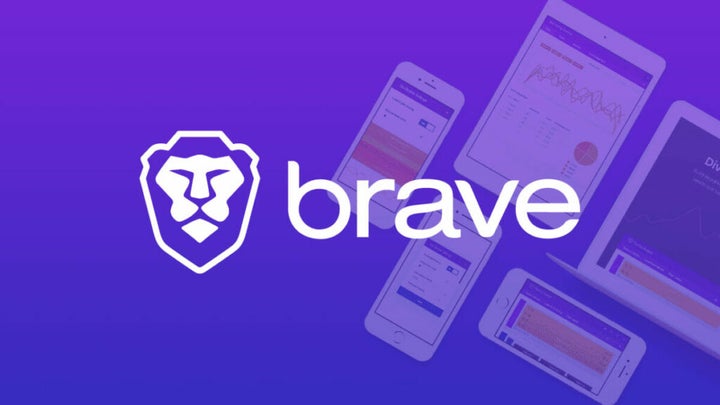
Ultimately, when deciding which browser is better comes down to personal preference.
Brave and Chrome both have their advantages and disadvantages, so it’s important to consider your individual needs when making a decision.
Brave is a great choice for those who value privacy and want to take control of their experience. With its built-in ad blocker, open source and better privacy feature, and cryptocurrency wallet, Brave offers users more control over their data and online activity. It also has a lightweight design that helps conserve battery life.
Google Chrome is an excellent choice for those who are concerned whether it’s open source or not and prioritize speed over any other feature. With its improved hardware acceleration, it allows the browser to take advantage of the computer’s graphics processing unit (GPU) to perform complex tasks, such as rendering graphics and animations.
By leveraging hardware acceleration, Google Chrome can offload some of the processing tasks from the central processing unit (CPU) and provide a smoother and faster browsing experience.
It also has a large library of extensions available in the Chrome Web Store.
Is Brave More Private Than Chrome?
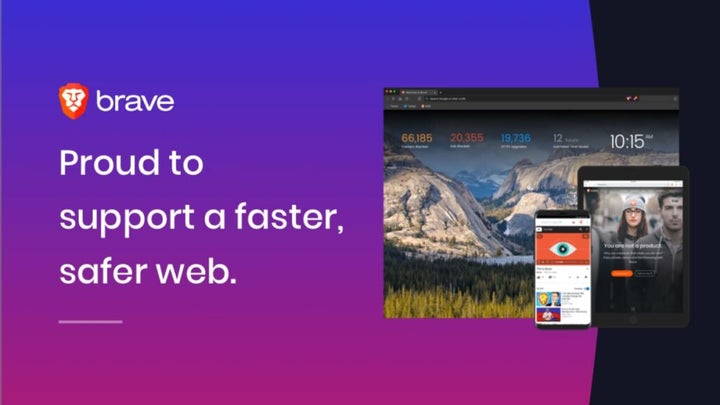
When it comes to privacy, Brave is the clear winner. Brave has a built-in ad blocker and privacy features that make it easier for users to control their browsing experience.
It also has a search engine called Brave Search, which is a privacy-focused search engine that doesn’t track users’ data or history.
Google Chrome does have some privacy features, such as Incognito Mode and Do Not Track, but these are not as comprehensive as those offered by Brave.
Chrome’s hardware acceleration can be used to track user activity, making it less secure than Brave.
Is There a Better Alternative?
There are several up-and-coming browsers that deserve your attention. Here are four alternatives to Brave and Chrome that are worth checking out:
Tempest

- Blocks trackers and ads by default.
- Offers a unique blacklist feature that allows users to block specific websites from tracking them.
- Intuitive and easy-to-use interface.
- Fast and responsive browsing experience.
Mozilla Firefox
- Open-source, community-driven browser.
- Highly customizable with numerous add-ons and extensions.
- Robust privacy protections with enhanced tracking protection and strict cookie policies.
- Emphasis on user control and ownership of data.
Vivaldi
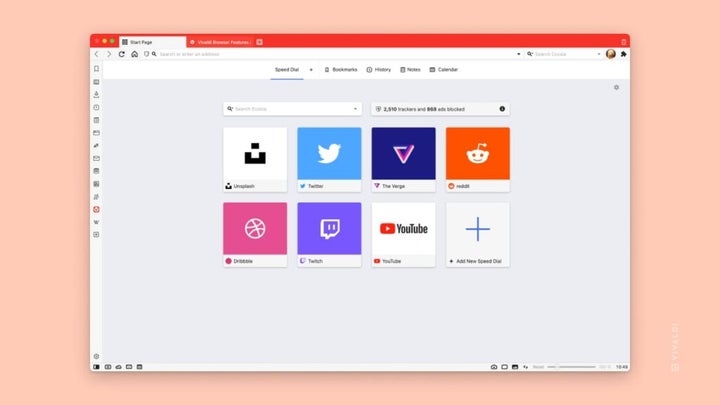
- Flexible interface with many customization options.
- Advanced tab management features.
- Built-in tools for taking notes, screenshots, and monitoring the weather.
- Strong privacy and security features, including ad-blocking and fingerprinting protection.
Microsoft Edge
- Developed with an emphasis on speed and performance.
- Offers seamless integration with Windows 10 and other Microsoft services.
- Industry-leading privacy controls, including tracking prevention and private browsing.
- Built-in immersive reader mode for distraction-free online reading.
While Brave and Chrome are popular browsers, with strong privacy and security protections, they’re not the only options available. By exploring alternatives like Tempest, Firefox, Vivaldi, and Edge, you can find a browser that’s tailored to your specific needs and preferences. Whether you prioritize customization, performance, or niche features, there’s a browser out there that has you covered.
Summary
In the age of big data and targeted advertising, finding a browser that respects your privacy and security is more critical than ever.
While Brave and Chrome are two of the most popular options on the market, there are several alternatives that offer unique benefits for users.
From the sleek and customizable Vivaldi to the community-driven Firefox, each of these browsers provides a different experience that prioritizes user control and protection.
By exploring the variety of options available, you can find a browser that aligns with your values and needs.
Ultimately, the browser you choose will determine the level of control and security you have over your online activity, so make sure to choose wisely.
You may also like

BYD Sets New Standards in Electric Vehicle Performance and Efficiency
Read more

After the Hertz attack, what can we do to protect our data?
Read more

Electric Supercar Achieves 1,000 Horsepower and Double Downforce in Historic Test
Read more

What you can do with the Gemini extension for Google Photos and why you should try it now
Read more

How to reliably check your internet speed
Read more

Stellantis Expands EV Lineup Amid Tariff Challenges
Read more
